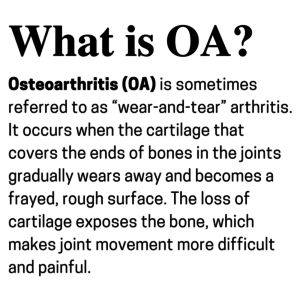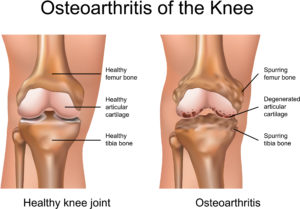You have Osteoarthritis…What’s Next?
You decided to see an orthopedic doctor about your painful joint, and the physician says you have osteoarthritis. You are probably asking, “Now what do I do?”
After being diagnosed with OA, your orthopedic physician will go through several treatment options with you based on the severity of your arthritis. In most cases, they will recommend nonsurgical treatments to start.
We talked with orthopedic surgeon Dr. Walker Flannery about some of these nonsurgical methods to better understand how they help relieve the symptoms of osteoarthritis.
Medications
One of the simplest ways to try and help relieve the pain, stiffness, and swelling from arthritis is taking over-the-counter medications such as:
- Ibuprofen – Max does of 2400 mg per day, split into three equal doses
- Naproxen (Aleve) – Max dose of 880 mg per day, split into two equal doses
- Acetaminophen (Tylenol) – Max dose of 3000 mg per day, split into three equal doses
(Please consult with your primary care physician before taking any of the above medications).
“These over-the-counter medications not only help relieve pain, but many will actually reduce inflammation within the joint,” says Dr. Flannery.
Lifestyle Changes
In addition to over-the-counter medications, there are many lifestyle changes that a person can make to help with joint pain. These include:
- Staying active, but switching to lower impact activities like walking, biking, swimming, and yoga.
- Maintaining a healthy weight to reduce the pressure put on joints like the knees and hips.
- Using an assistive device such as a cane or walking stick.
Physical Therapy
“Physical therapy helps maintain or increase range of motion within the joint,” says Dr. Flannery. “It also builds muscle strength, which may help relieve any extra pressure being put on the joint.”
Doing physical therapy at this stage (prior to surgery) can also help with the recovery and overall outcome if a joint replacement surgery is eventually needed.
Injections
A fourth nonsurgical option for arthritis management is joint injections. This treatment method is used to deliver medication directly into the arthritic joint to reduce inflammation and relieve pain.
One type is a cortisone (steroid) injection that reduces inflammation within a joint, which can significantly reduce pain. A second type of injection uses a solution that lubricates the joint to reduce pain and improve range of motion and mobility within the joint.
“Any of these nonsurgical methods can be used for arthritis in the hips, knees, shoulders, or other joints,” says Dr. Flannery. “Our goal with recommending these options is to relieve a patient’s symptoms and see if surgery can be delayed or even prevented.”
It’s also important to note that many insurance plans require patients to try nonsurgical methods prior to having a joint replacement surgery if they are looking to have the procedure covered under insurance benefits.
Dr. Walker Flannery is the newest orthopedic surgeon to join the OSMS team. To make an appointment with him or any of the other OSMS physicians, call 920-430-8113.








